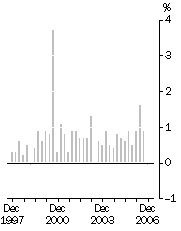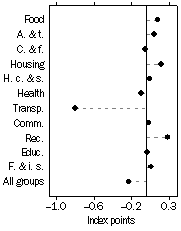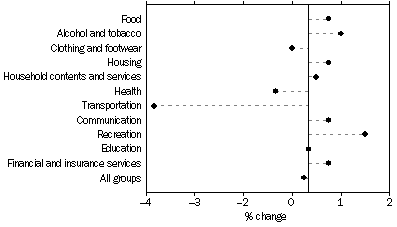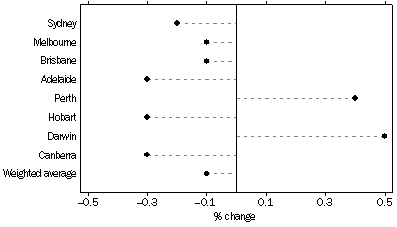PRICE INDEXES AND CONTRACT PRICE INDEXATION
1 ALL GROUPS, INDEX NUMBERS(a)
2 ALL GROUPS, PERCENTAGE CHANGES
CPI All GROUPS, WEIGHTED AVERAGE OF EIGHT CAPITAL CITIES, INDEX NUMBERS(a)
DECEMBER QTR KEY FIGURES
 | Sep Qtr 2006 to
Dec Qtr 2006 | Dec Qtr 2005 to
Dec Qtr 2006 |
| Weighted average of eight capital cities | % change | % change |
|
| Food | 0.5 | 8.6 |
| Alcohol and tobacco | 0.8 | 3.5 |
| Clothing and footwear | -0.4 | -2.0 |
| Housing | 0.5 | 3.2 |
| Household contents and services | 0.2 | 1.9 |
| Health | -0.8 | 5.3 |
| Transportation | -3.8 | 1.1 |
| Communication | 0.5 | 1.7 |
| Recreation | 1.4 | 2.4 |
| Education | 0.0 | 4.8 |
| Financial and insurance services | 0.5 | 1.4 |
| All groups | -0.1 | 3.3 |
| All groups excluding Housing and Financial and insurance services | -0.3 | 3.6 |
|
All Groups,
Quarterly change

| Contribution to quarterly change,
December quarter 2006

|
DECEMBER QTR KEY POINTS
THE ALL GROUPS CPI
- fell 0.1% in the December quarter 2006 down from an increase of 0.9% in the September quarter.
- rose 3.3% through the year to December quarter 2006.
OVERVIEW OF CPI MOVEMENTS
- The most significant price falls this quarter were automotive fuel (-12.4%), fruit (-5.2%), pharmaceuticals (-5.0%) and audio, visual and computing equipment (-2.7%).
- The decrease in automotive fuel contributed -0.86 index points to the December quarter CPI movement.
- The most significant offsetting price increases were domestic travel and accommodation (+6.2%), vegetables (+4.1%), rents (+1.0%) and house purchase (+0.5%).
NOTES
FORTHCOMING ISSUES
| ISSUE (QUARTER) | Release Date |
| March 2007 | 24 April 2007 |
| June 2007 | 25 July 2007 |
ROUNDING
Any discrepancies between totals and sums of components in this publication are due to rounding.
CHANGES IN THIS ISSUE
This issue includes an Appendix on the Treatment of child-care services in the Australian Consumer Price Index (CPI).
ABBREVIATIONS
ABS Australian Bureau of Statistics
CPI Consumer Price Index
INQUIRIES
For further information about these and related statistics, contact Lee Taylor on Canberra (02) 6252 6251 or the National Information and Referral Service on 1300 135 070.
SUMMARY COMMENTARY
MAIN CONTRIBUTORS TO CHANGE
CPI GROUPS
Weighted average of eight capital cities, Percentage change from previous quarter

The discussion of the CPI groups below is ordered in terms of their significance to the change in All groups index points (see tables 6 and 7).
TRANSPORTATION (-3.8%)
The main contributor to the 3.8% fall in transportation this quarter was the fall in the price of automotive fuel (-12.4%), with average quarterly prices returning to the lowest levels since June Quarter 2005. All other categories in transportation rose, with motor vehicle repair and servicing (+1.0%) and motor vehicles (+0.3%) being the most significant.
Automotive fuel prices fell in July (-0.5%), August (-0.1%), September (-8.9%), October (-6.3%) and November (-1.9%) then rose in December (+2.8%). The automotive fuel expenditure class contributed -0.86 index points to the change in the All Groups CPI in December quarter 2006 and -0.15 index points to the through the year change.
The following graph shows the pattern of the average daily prices for unleaded petrol for the eight capital cities over the last fifteen months.
The rise in motor vehicle repair and servicing was due to rises in both parts and mechanics' labour. The rise in motor vehicles was mostly due to the introduction of a number of new models.
Through the year to December quarter 2006, the transportation group rose 1.1%, with the main contributors being motor vehicle repair and servicing (+4.1%), motor vehicles (+1.5%) and other motoring charges (+4.6%). A fall in automotive fuel (-2.3%) provided the only offset.
RECREATION (+1.4%)
Recreation recorded its strongest quarterly increase since September quarter 2005, due mainly to domestic holiday travel and accommodation (+6.2%). This increase resulted from a seasonal increase in accommodation tariffs and airfares. Overseas holiday travel and accommodation also rose (+1.2%).
The major offsetting price fall was in audio, visual and computing equipment (-2.7%), reflecting ongoing price falls in this category.
Annually, Recreation rose 2.4% with the strongest rises in holiday travel and accommodation, with the domestic component increasing by 7.6% and the overseas component by 5.9%. Over the same period, audio, visual and computing equipment fell by 8.0%.
HOUSING (+0.5%)
The rise in housing this quarter was mainly due to rents (+1.0%) and house purchase (+0.5%).
Increases in average rents were recorded in all capital cities and range from Perth (+1.8%) to Hobart (+0.6%). House purchase average price movements range from Darwin (+4.2%) to Sydney (-0.4%).
Through the year to December quarter 2006, the housing group rose 3.2%. This rise was mainly attributable to rents (+3.7%), house purchase (+2.1%), and property rates and charges (+5.6%). Annually, housing increases were led by rises in Darwin (+9.5%) and Perth (+7.7%).
FOOD (+0.5%)
The rise in food prices was largely due to vegetables (+4.1%), cakes and biscuits (+2.0%), restaurant meals (+0.8%), bread (+1.8%) and take away and fast foods (+0.6%). This was offset by price falls in fruit (-5.2%) and Beef and veal (-1.9%).
The increase in prices of vegetables resulted from adverse effects of weather conditions on vegetable crops leading to shortages in the supply of many vegetables.
The fall in fruit prices was largely due to the lower quarterly average price of bananas. Following an increase of 406% over the June and September quarters 2006, banana prices fell 19% in December quarter. Prices remained high in October and early November before falling consistently through the remainder of the quarter. With the exception of melons all other fruit rose.
Over the twelve months to December quarter 2006, food prices rose 8.6%, mainly due to increases in fruit (+72.2%). The only significant offsetting annual fall was in poultry (-3.0%).
ALCOHOL AND TOBACCO (+0.8%)
Three of the four components in the alcohol and tobacco group rose this quarter with contributions from beer (+1.2%), spirits (+1.5%) and tobacco (+0.6%). Wine prices fell slightly (-0.1%).
The rises in beer, spirit, and tobacco prices can be attributed to the discontinuation of specials and to the flow on effects of the increase in Federal excise and customs duty from 1 August.
Through the year to December quarter 2006, the alcohol and tobacco group rose 3.5%, with rises in all categories except wine, which fell 0.3% over the year.
HEALTH (-0.8%)
The fall in health costs in December quarter 2006 was due to a fall in the net cost of pharmaceuticals (-5.0%) more than offsetting a rise in the net cost of hospital and medical services (+0.4%).
The fall in the net cost of pharmaceuticals was due to the cyclical effect of the Pharmaceutical Benefits Scheme. The number of people accessing the PBS Safety Net benefits reaches a peak in the December quarter. There was a slight rise in gross pharmaceutical prices.
The small rise in the net cost of hospital and medical services was due to the combined effects of gross price increases across all services, static Bulk Billing percentages and the cyclical effect of the Medicare Plus Safety Net.
Over the year to December quarter 2006, the health group rose 5.3%, with the largest component increase in net hospital and medical services (+6.4%).
TRADABLES AND NON-TRADABLES
The non-tradables component (see table 8) of the CPI rose 0.8% in the December quarter. This component includes goods and services whose prices are largely determined by domestic price pressures and represents approximately 58% of the CPI. Within non-tradables, the services component rose 0.9%, mainly due to domestic holiday travel & accommodation and rents. The major offset was provided by insurance services. The non-tradable goods component rose 0.7% mainly due to house purchase.
The tradables component of the All groups CPI fell 1.4%. This component includes goods and services whose prices are largely determined on the world market and represents approximately 42% of the weight of the CPI. The main contributors to the decrease were automotive fuel, fruit and pharmaceuticals. The most significant offset was a rise in vegetables.
Through the year to December quarter 2006, tradables rose 2.9% and non-tradables rose 3.5%. This compares with rises of 4.4% and 3.6%, respectively, for these components through the year to September quarter 2006.
CAPITAL CITIES COMPARISON
ALL GROUPS
All Groups: Percentage change from previous quarter

At the All groups level, the CPI fell in Adelaide (-0.3%), Hobart (-0.3%), Canberra (-0.3%), Sydney (-0.2%), Melbourne (-0.1%) and Brisbane (-0.1%). It rose in Darwin (+0.5%) and Perth (+0.4%).
Significant falls in automotive fuel prices were recorded in all cities. In Darwin these fuel price falls were more than offset by higher than average Housing (+2.3%) and Food (+1.1%) costs. Similarly, the result in Perth was driven mostly by higher than average prices in Recreation (+2.8%) and Housing (+0.7%).
Through the year to December quarter 2006, the All groups CPI rose in all capital cities with the increases ranging from 2.5% in Hobart to 5.0% in Darwin. The higher result for Darwin was largely due to a 9.5% rise in Housing, nearly triple the 3.2% increase for the weighted average of eight capital cities. Perth also recorded a rise for Housing (+7.7%) that was well above the national average.
CPI, All groups index numbers and percentage changes |
|
 | Index number(a) |  | Percentage change |
 |
|  |
|
 |
Dec Qtr 2006
|  | Sep Qtr 2006
to Dec Qtr 2006 | Dec Qtr 2005
to Dec Qtr 2006 |
|
| Sydney | 155.8 |  | -0.2 | 3.2 |
| Melbourne | 153.5 |  | -0.1 | 2.9 |
| Brisbane | 157.3 |  | -0.1 | 3.4 |
| Adelaide | 158.8 |  | -0.3 | 3.0 |
| Perth | 155.5 |  | 0.4 | 4.4 |
| Hobart | 154.7 |  | -0.3 | 2.5 |
| Darwin | 152.6 |  | 0.5 | 5.0 |
| Canberra | 155.6 |  | -0.3 | 3.1 |
| Weighted average of eight capital cities | 155.5 |  | -0.1 | 3.3 |
|
| (a) Base of each index: 1989-90 = 100.0. |
 |
SELECTED TABLES FROM CONSUMER PRICE INDEX, AUSTRALIA (CAT. NO. 6401.0)
| 1 ALL GROUPS, INDEX NUMBERS(a) |  |
ALL GROUPS, Index numbers(a)
|
|
| Period | Sydney | Melbourne | Brisbane | Adelaide | Perth | Hobart | Darwin | Canberra | Weighted
average
of eight
capital
cities |
|
| 2002-03 | 141.1 | 139.7 | 140.7 | 142.7 | 136.8 | 139.1 | 136.8 | 139.7 | 140.2 |
| 2003-04 | 144.1 | 142.8 | 144.8 | 147.0 | 139.6 | 142.6 | 138.7 | 143.4 | 143.5 |
| 2004-05 | 147.7 | 145.7 | 148.5 | 150.4 | 144.0 | 147.1 | 141.8 | 146.7 | 147.0 |
| 2005-06 | 152.1 | 150.2 | 153.2 | 155.2 | 150.1 | 151.8 | 146.5 | 151.9 | 151.7 |
| 2002 |  |  |  |  |  |  |  |  |  |
| December | 140.4 | 139.0 | 139.9 | 141.5 | 136.4 | 138.0 | 136.2 | 139.2 | 139.5 |
| 2003 |  |  |  |  |  |  |  |  |  |
| March | 142.1 | 140.9 | 141.8 | 144.6 | 137.4 | 140.0 | 137.5 | 140.7 | 141.3 |
| June | 142.2 | 140.9 | 141.8 | 144.3 | 137.4 | 140.8 | 137.9 | 140.7 | 141.3 |
| September | 142.4 | 141.8 | 143.3 | 145.4 | 138.6 | 141.1 | 137.8 | 141.9 | 142.1 |
| December | 143.6 | 142.1 | 144.2 | 146.2 | 139.2 | 142.0 | 138.5 | 142.9 | 142.8 |
| 2004 |  |  |  |  |  |  |  |  |  |
| March | 145.0 | 143.5 | 145.4 | 147.7 | 139.6 | 143.0 | 139.0 | 143.9 | 144.1 |
| June | 145.5 | 143.9 | 146.3 | 148.6 | 141.0 | 144.3 | 139.6 | 144.8 | 144.8 |
| September | 146.2 | 144.2 | 146.8 | 149.0 | 142.0 | 145.0 | 140.8 | 145.5 | 145.4 |
| December | 147.3 | 145.3 | 148.0 | 150.0 | 143.3 | 146.7 | 141.1 | 146.3 | 146.5 |
| 2005 |  |  |  |  |  |  |  |  |  |
| March | 148.2 | 146.4 | 149.2 | 150.9 | 144.4 | 148.0 | 141.9 | 147.0 | 147.5 |
| June | 149.0 | 146.9 | 150.0 | 151.8 | 146.3 | 148.8 | 143.2 | 147.8 | 148.4 |
| September | 150.5 | 148.6 | 150.9 | 153.4 | 147.8 | 150.1 | 144.7 | 149.7 | 149.8 |
| December | 151.0 | 149.2 | 152.1 | 154.1 | 149.0 | 151.0 | 145.4 | 150.9 | 150.6 |
| 2006 |  |  |  |  |  |  |  |  |  |
| March | 152.2 | 150.5 | 153.5 | 155.6 | 150.5 | 152.2 | 146.7 | 152.2 | 151.9 |
| June | 154.7 | 152.6 | 156.2 | 157.6 | 153.2 | 154.0 | 149.2 | 154.9 | 154.3 |
| September | 156.1 | 153.7 | 157.5 | 159.3 | 154.9 | 155.1 | 151.8 | 156.0 | 155.7 |
| December | 155.8 | 153.5 | 157.3 | 158.8 | 155.5 | 154.7 | 152.6 | 155.6 | 155.5 |
|
| (a) Base of each index: 1989-90 = 100.0. |
|
| 2 ALL GROUPS, PERCENTAGE CHANGES |  |
ALL GROUPS, Percentage changes
|
|
| Period | Sydney | Melbourne | Brisbane | Adelaide | Perth | Hobart | Darwin | Canberra | Weighted
average
of eight
capital
cities |
Percentage Change (from previous financial year) |
|
| 2002-03 | 2.8 | 3.3 | 3.2 | 4.0 | 2.8 | 3.3 | 2.3 | 3.3 | 3.1 |
| 2003-04 | 2.1 | 2.2 | 2.9 | 3.0 | 2.0 | 2.5 | 1.4 | 2.6 | 2.4 |
| 2004-05 | 2.5 | 2.0 | 2.6 | 2.3 | 3.2 | 3.2 | 2.2 | 2.3 | 2.4 |
| 2005-06 | 3.0 | 3.1 | 3.2 | 3.2 | 4.2 | 3.2 | 3.3 | 3.5 | 3.2 |
|
Percentage Change (from corresponding quarter of previous year)
|
|
| 2002 |  |  |  |  |  |  |  |  |  |
| December | 2.8 | 3.1 | 3.0 | 3.6 | 2.9 | 3.1 | 2.0 | 3.2 | 3.0 |
| 2003 |  |  |  |  |  |  |  |  |  |
| March | 3.0 | 3.6 | 3.4 | 5.0 | 2.8 | 3.6 | 2.8 | 3.8 | 3.4 |
| June | 2.4 | 2.9 | 2.7 | 3.7 | 2.1 | 2.8 | 2.1 | 2.6 | 2.7 |
| September | 2.0 | 2.9 | 2.9 | 3.6 | 2.1 | 2.6 | 1.8 | 2.8 | 2.6 |
| December | 2.3 | 2.2 | 3.1 | 3.3 | 2.1 | 2.9 | 1.7 | 2.7 | 2.4 |
| 2004 |  |  |  |  |  |  |  |  |  |
| March | 2.0 | 1.8 | 2.5 | 2.1 | 1.6 | 2.1 | 1.1 | 2.3 | 2.0 |
| June | 2.3 | 2.1 | 3.2 | 3.0 | 2.6 | 2.5 | 1.2 | 2.9 | 2.5 |
| September | 2.7 | 1.7 | 2.4 | 2.5 | 2.5 | 2.8 | 2.2 | 2.5 | 2.3 |
| December | 2.6 | 2.3 | 2.6 | 2.6 | 2.9 | 3.3 | 1.9 | 2.4 | 2.6 |
| 2005 |  |  |  |  |  |  |  |  |  |
| March | 2.2 | 2.0 | 2.6 | 2.2 | 3.4 | 3.5 | 2.1 | 2.2 | 2.4 |
| June | 2.4 | 2.1 | 2.5 | 2.2 | 3.8 | 3.1 | 2.6 | 2.1 | 2.5 |
| September | 2.9 | 3.1 | 2.8 | 3.0 | 4.1 | 3.5 | 2.8 | 2.9 | 3.0 |
| December | 2.5 | 2.7 | 2.8 | 2.7 | 4.0 | 2.9 | 3.0 | 3.1 | 2.8 |
| 2006 |  |  |  |  |  |  |  |  |  |
| March | 2.7 | 2.8 | 2.9 | 3.1 | 4.2 | 2.8 | 3.4 | 3.5 | 3.0 |
| June | 3.8 | 3.9 | 4.1 | 3.8 | 4.7 | 3.5 | 4.2 | 4.8 | 4.0 |
| September | 3.7 | 3.4 | 4.4 | 3.8 | 4.8 | 3.3 | 4.9 | 4.2 | 3.9 |
| December | 3.2 | 2.9 | 3.4 | 3.0 | 4.4 | 2.5 | 5.0 | 3.1 | 3.3 |
Percentage Change (from previous quarter) |
|
| 2002 |  |  |  |  |  |  |  |  |  |
| December | 0.6 | 0.9 | 0.5 | 0.9 | 0.4 | 0.4 | 0.6 | 0.8 | 0.7 |
| 2003 |  |  |  |  |  |  |  |  |  |
| March | 1.2 | 1.4 | 1.4 | 2.2 | 0.7 | 1.4 | 1.0 | 1.1 | 1.3 |
| June | 0.1 | 0.0 | 0.0 | -0.2 | 0.0 | 0.6 | 0.3 | 0.0 | 0.0 |
| September | 0.1 | 0.6 | 1.1 | 0.8 | 0.9 | 0.2 | -0.1 | 0.9 | 0.6 |
| December | 0.8 | 0.2 | 0.6 | 0.6 | 0.4 | 0.6 | 0.5 | 0.7 | 0.5 |
| 2004 |  |  |  |  |  |  |  |  |  |
| March | 1.0 | 1.0 | 0.8 | 1.0 | 0.3 | 0.7 | 0.4 | 0.7 | 0.9 |
| June | 0.3 | 0.3 | 0.6 | 0.6 | 1.0 | 0.9 | 0.4 | 0.6 | 0.5 |
| September | 0.5 | 0.2 | 0.3 | 0.3 | 0.7 | 0.5 | 0.9 | 0.5 | 0.4 |
| December | 0.8 | 0.8 | 0.8 | 0.7 | 0.9 | 1.2 | 0.2 | 0.5 | 0.8 |
| 2005 |  |  |  |  |  |  |  |  |  |
| March | 0.6 | 0.8 | 0.8 | 0.6 | 0.8 | 0.9 | 0.6 | 0.5 | 0.7 |
| June | 0.5 | 0.3 | 0.5 | 0.6 | 1.3 | 0.5 | 0.9 | 0.5 | 0.6 |
| September | 1.0 | 1.2 | 0.6 | 1.1 | 1.0 | 0.9 | 1.0 | 1.3 | 0.9 |
| December | 0.3 | 0.4 | 0.8 | 0.5 | 0.8 | 0.6 | 0.5 | 0.8 | 0.5 |
| 2006 |  |  |  |  |  |  |  |  |  |
| March | 0.8 | 0.9 | 0.9 | 1.0 | 1.0 | 0.8 | 0.9 | 0.9 | 0.9 |
| June | 1.6 | 1.4 | 1.8 | 1.3 | 1.8 | 1.2 | 1.7 | 1.8 | 1.6 |
| September | 0.9 | 0.7 | 0.8 | 1.1 | 1.1 | 0.7 | 1.7 | 0.7 | 0.9 |
| December | -0.2 | -0.1 | -0.1 | -0.3 | 0.4 | -0.3 | 0.5 | -0.3 | -0.1 |
|
| LONGER TERM SERIES: |  |
CPI All Groups, Weighted Average of Eight Capital Cities, Index Numbers(a)
|
 |  |  |  | Quarter ending |
|
| Year | 31 March | 30 June | 30 September | 31 December |
|
| 1985 | 68.1 | 69.7 | 71.3 | 72.7 |
| 1986 | 74.4 | 75.6 | 77.6 | 79.8 |
| 1987 | 81.4 | 82.6 | 84.0 | 85.5 |
| 1988 | 87.0 | 88.5 | 90.2 | 92.0 |
| 1989 | 92.9 | 95.2 | 97.4 | 99.2 |
| 1990 | 100.9 | 102.5 | 103.3 | 106.0 |
| 1991 | 105.8 | 106.0 | 106.6 | 107.6 |
| 1992 | 107.6 | 107.3 | 107.4 | 107.9 |
| 1993 | 108.9 | 109.3 | 109.8 | 110.0 |
| 1994 | 110.4 | 111.2 | 111.9 | 112.8 |
| 1995 | 114.7 | 116.2 | 117.6 | 118.5 |
| 1996 | 119.0 | 119.8 | 120.1 | 120.3 |
| 1997 | 120.5 | 120.2 | 119.7 | 120.0 |
| 1998 | 120.3 | 121.0 | 121.3 | 121.9 |
| 1999 | 121.8 | 122.3 | 123.4 | 124.1 |
| 2000 | 125.2 | 126.2 | 130.9 | 131.3 |
| 2001 | 132.7 | 133.8 | 134.2 | 135.4 |
| 2002 | 136.6 | 137.6 | 138.5 | 139.5 |
| 2003 | 141.3 | 141.3 | 142.1 | 142.8 |
| 2004 | 144.1 | 144.8 | 145.4 | 146.5 |
| 2005 | 147.5 | 148.4 | 149.8 | 150.6 |
| 2006 | 151.9 | 154.3 | 155.7 | 155.5 |
|
| (a) Base of each index:1989-90 = 100.0 |
 Print Page
Print Page
 Print All
Print All